Peter Lobner
During his second voyage in 1773, British Captain James Cook became the first to cross the Antarctic Circle, but he was turned back by heavy sea ice without ever sighting the coast of Antarctica. It took 47 years before a Russian expedition, led by Estonian Fabien von Bellingshausen, sighted the coast of Antarctica. As the expedition leader, Bellingshausen generally is credited with the discovery of Antarctica on 28 January 1820. Just two days later, on 30 January 1820, a British expedition to the South Shetland Islands, led by Irish Lieutenant Edward Bransfield, sighted the tip of the Antarctic Peninsula. Bransfield is credited by some with the discovery of Antarctica. In this post, we’ll take a look at the voyages of these three pioneering Antarctic explorers.
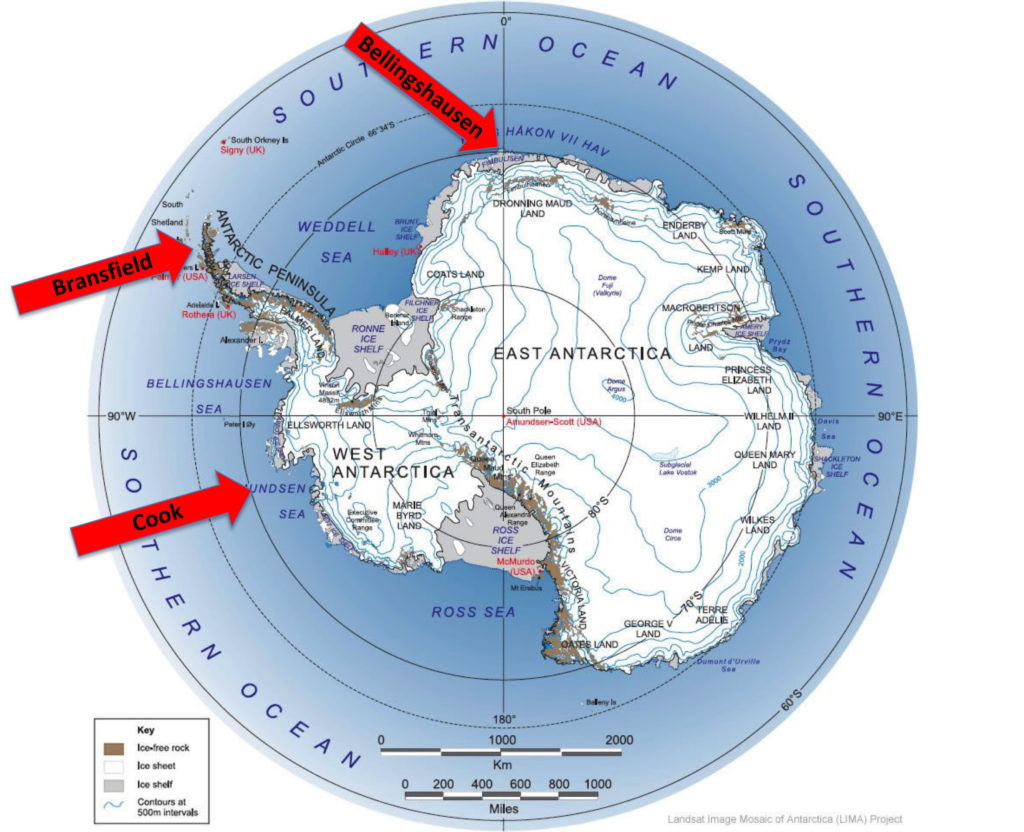
Map of Antarctica and the Southern Ocean showing the topography of Antarctica (as blue lines), research stations of the United States and the United Kingdom (in red text), ice-free rock areas (in brown), ice shelves (in gray) and names of the major ocean water bodies (in blue uppercase text). Source: adapted from LIMA Project (Landsat Image Mosaic of Antarctica) via Wikipedia
Captain James Cook – First crossing of the Antarctic Circle, 17 January 1773
Setting out on their second voyage from England in July 1772, Captain James Cook (1728-1779) and his crew, on His Majesty’s Ship Resolution, circumnavigated the globe travelling as far south as possible to determine whether there actually was a great southern continent. The route covered during this voyage is shown in the following map.
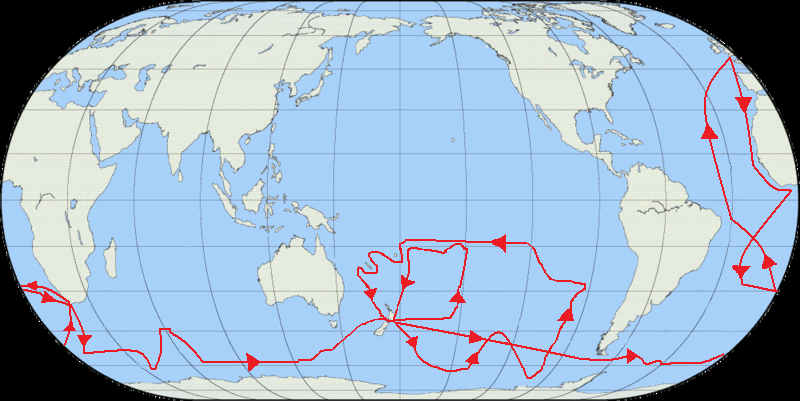
On 17 January 1773, Cook made the first recorded crossing of the Antarctic Circle, which he reported in his log:
“At about a quarter past 11 o’clock we cross’d the Antarctic Circle, for at Noon we were by observation four miles and a half south of it and are undoubtedly the first and only ship that ever cross’d that line.”
Cook crossed the Antarctic Circle three times during his second voyage. The last crossing, on 30 January 1773, was to be the most southerly penetration of Antarctic waters, reaching latitude 71°10’ S, longitude 106°54’ W. The ship was forced back due to solid sea ice. Cook came within about 240 km (150 mi) of the Antarctic mainland on his second voyage.
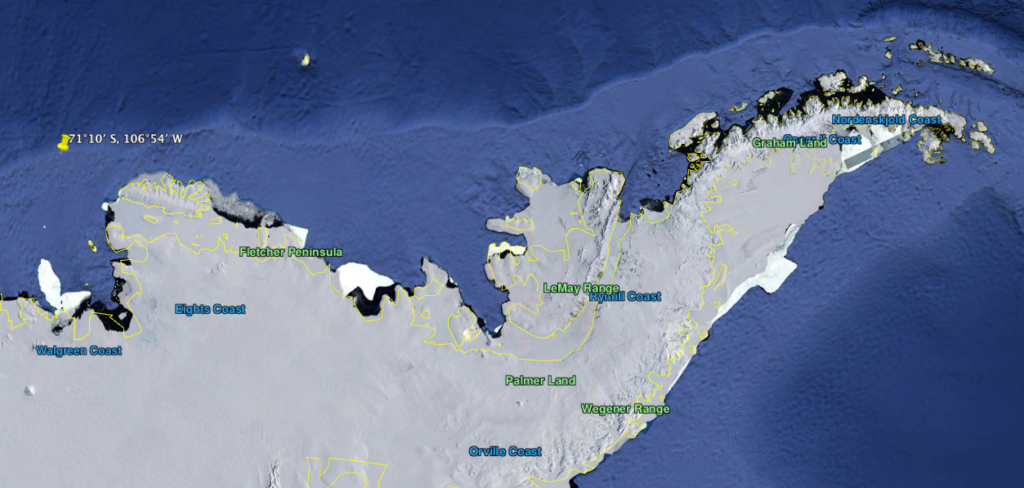
Fabien von Bellingshausen – First sighting of Antarctica, 28 January 1820
In 1818, the Russian Empire, ruled by Czar Alexander I, organized two expeditions to study the polar regions, one for mapping the Arctic and one for sailing further south than Captain James Cook’s second voyage 45 years earlier. The southern polar expedition was led by the prominent cartographer Fabien Gottlieb Benjamin von Bellingshausen, who was born in 1778 on Saaremaa, the largest island in today’s Republic of Estonia. This was to became known as the Bellingshausen Expedition.
The expedition consisted of two ships, Bellingshausen’s 985 ton flagship sloop Vostok, and the 530 ton support sloop Mirnyi, under the command of Mikhail Lazarev (Bellingshausen’s second-in-command). An exhibit at the Estonian Maritime Museum in Tallinn reported: “The largest proportion (a whopping 65.8 tons) of the food stock on the Bellingshausen expedition consisted of wheat and rye cookies. In addition, they brought 28 tons of salted meat and 20.5 tons of dried peas. In ports, the crew also acquired cereal and fresh food.” In Antarctic waters, icebergs would supply their fresh water needs.
On 4 June 1819, the expedition departed from the Russian naval island base at Kronstadt, just off the coast from Saint Petersburg. Seven months later, the expedition crossed the Antarctic Circle on 26 January 1820.
The Bellingshausen expedition is credited with being the first to reach Antarctica on 28 January 1820, when the two ships approached to within 20 miles (32 km) of the Antarctic coast, at latitude 69°21’28” S, longitude 2°14’50” W, in an area now known as Princess Martha Coast in East Antarctica. Bellingshausen reported sighting an ice shelf that today is known as the Fimbul ice shelf.
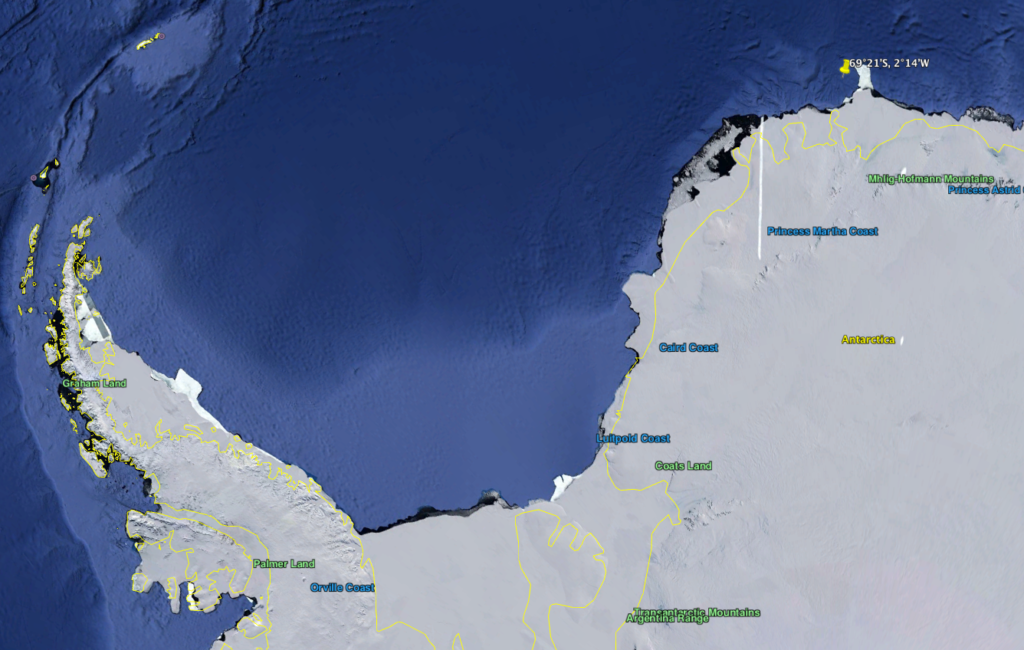
(yellow pin, upper right). Source: Google Earth
Bellingshausen did not claim to have discovered Antarctica, but his descriptions of what he saw agree very well with what the Princess Martha Coast is now known to look like. On the basis of this sighting and the coordinates given in his log book, Bellingshausen generally is credited (e.g., the British polar historian A. G. E. Jones) with the discovery of the Antarctic continent.
In their subsequent circumnavigation of the Antarctic continent, Bellingshausen and Lazarev became the first explorers to see and officially discover several parts of the Antarctic landmass. On 22 February 1820, the Vostok and Mirnyi were hit by the worst storm of the voyage and were forced to sail north, arriving in Sydney, Australia in April. After several months exploring the South Pacific and then hearing about the sighting of Antarctica by the British (Edward Bransfield and William Smith), the Bellingshausen Expedition sailed from Sydney on 11 November 1820 to continue exploring the Antarctic. On 24 December 1820, the two ships once again were south of the Antarctic Circle. On this part of the voyage, Bellingshausen discovered and named Peter I Island and the Alexander Coast, now known as Alexander Island, along the west coast of the Antarctic Peninsula.
The circumnavigation route followed by the Bellingshausen Expedition is shown in the following map. Bellingshausen became only the second explorer, after Cook, to have circumnavigated Antarctica.
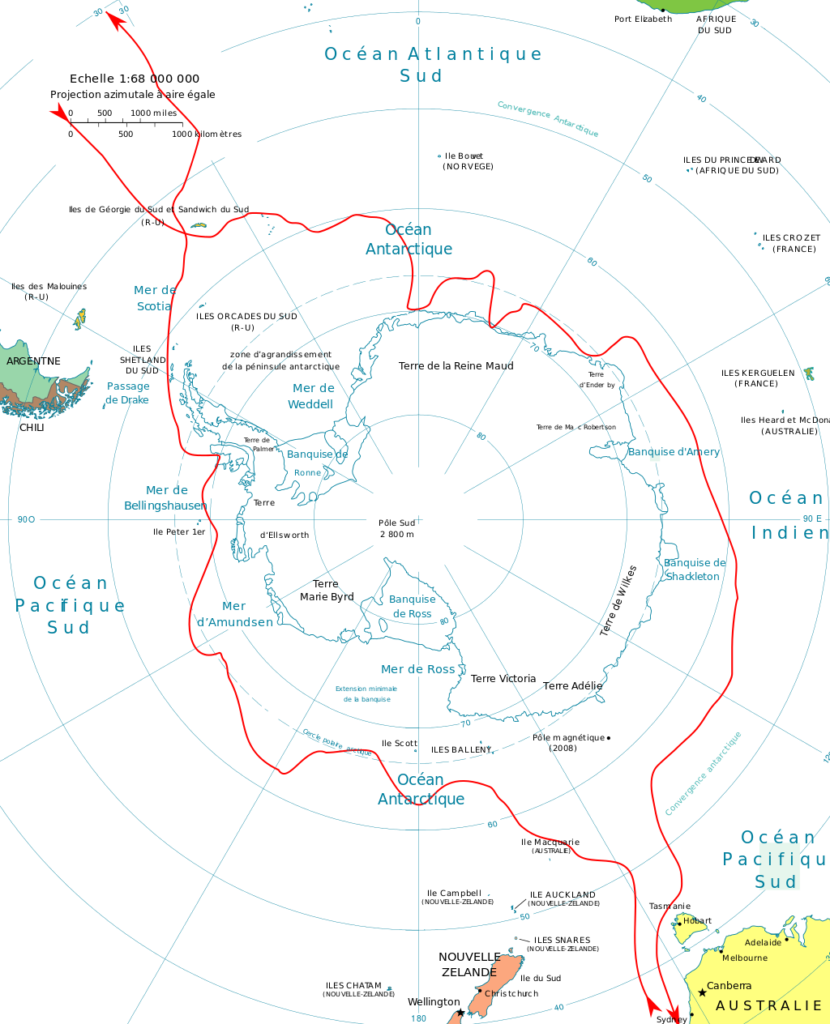
Source: Bourrichon via Wikipedia
The Bellingshausen expedition returned to Kronstadt on 4 August 1821, ending a voyage that had lasted two years and 21 days and covered about 50,000 miles (80,467 km). After his return, Bellingshausen was promoted to the rank of Admiral and Lazarev was promoted to the rank of Lieutenant–Captain. His travel account was not published until ten years later.
As part of the International Geophysical Year (IGY) in the mid-1950s, the Soviet Union established its first two Antarctic bases, which were named Mirnyi (established 13 February 1956) and Vostok (established 6 December 1957), in honor of the ships in the Bellingshausen Expedition.
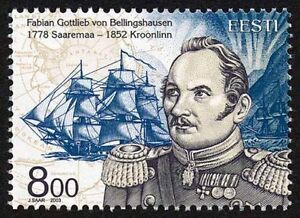
discovery of Antarctica. Source: eBay
The Bellingshausen expedition was commemorated on a 2003 Estonian stamp that features a portrait of Bellingshausen and a drawing of his flagship Vostok over a map showing the route of his Antarctic expedition.
Edward Bransfield – Sighting of Antarctica, 30 January 1820
In February 1819, British merchant ship owner William Smith, aboard his vessel The Williams, was sailing from Buenos Aires, Argentina to Valparaiso, Chile. To catch the prevailing winds, he sailed unusually far south of Cape Horn and, on 19 February 1819, sighted previously unknown islands in the Southern Ocean. To confirm his sighting and to chart the islands, Royal Navy officials in Valpariso chartered his ship and assigned Sailing Master Lieutenant Edward Bransfield, from Ballinacurra, Ireland (near Cork), to accompany Smith on an expedition back to the islands, which would become known as the South Shetland Islands. During this expedition, Bransfield landed on King George Island and took formal possession on behalf of King George III.
On 30 January 1820, Bransfield sighted the Trinity Peninsula, which is the northernmost tip of the Antarctic Peninsula. His sighting was made at about latitude 63°50’S and longitude 60°30’W.
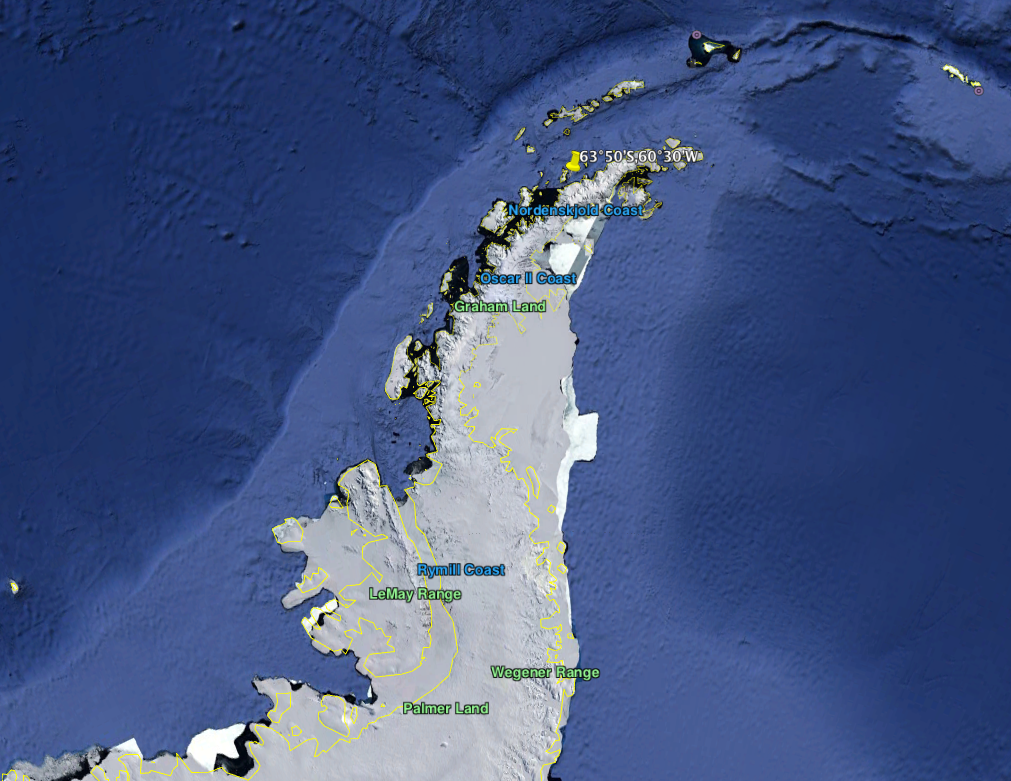
After the initial sighting, Bransfield charted a segment of the Trinity Peninsula and followed the edge of the ice sheet in a north-easterly direction, where he discovered various points on Elephant Island and Clarence Island, which he formally claimed for the British Crown. In his log, Bransfield made a note of two “high mountains, covered with snow”, one of which subsequently was named Mount Bransfield in his honor. The Bransfield Strait between the South Shetland Islands and the Antarctic Peninsula also was named in his honor in 1822 by Antarctic explorer James Weddell.

Since Bransfield’s sighting, the tip of the Antarctic Peninsula has been known variously as Trinity Land, Palmer Land, Graham Land, and Land of Louis Philippe. Prime Head is the northernmost point of this peninsula.
Bransfield’s expedition charts were given to the Admirality and currently are in the possession of the UK Hydrographic department in Taunton, Somerset.
In 2000, Bransfield’s historic achievement was recognized when the Royal Mail issued a stamp in his honor. Since no likeness of the man survives, the stamp depicted an image of the RRS Bransfield, a British Antarctic surveying vessel.

Source: Commonwealth Stamps Opinion
To commemorate the 200th anniversary of Edward Bransfield’s sighting of Antarctica (and some say, his discovery of Antarctica), a memorial by sculptor Matt Thompson will be erected in Ballinacurra, Ireland in January 2020.

Source: Tony Whelan photo, Afloat.ie
Estonia’s Antarktika 200 expedition

To commemorate the 200th anniversary of the discovery of Antarctica by the Bellingshausen Expedition, the Estonian Maritime Museum and NGO Thetis Expeditions have organized a scientific expedition from Kronstadt, Russia to the Antarctic peninsula by a crew of 12 aboard the 24 meter, 95 ton, Estonian-registered sailing yacht S/Y Admiral Bellingshausen.

Source: maritimetraffic.com
The planned route, which includes about 50 stops, and approximately follows the Bellingshausen’s route to and from the Southern Ocean, is shown in the following map. The crew will take samples of pollen, water and microplastics while on the voyage, for researchers at Estonia’s University of Tartu. The expedition includes food of Estonian origin to the largest possible extent, and probably a better selection of food than on Bellingshausen’s 1819 – 1821 voyage.
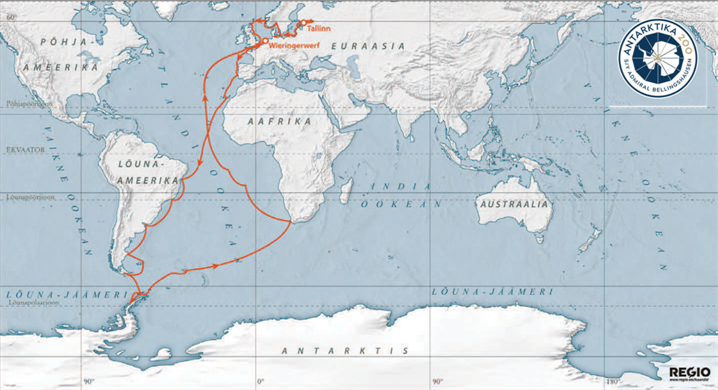
The ship departed Tallinn harbor on 14 July 2019, and headed for its first port of call at the historic Russian naval island base at Kronstadt, which was the starting point for the Bellingshausen Expedition.
You can follow the current position on the S/Y Admiral Bellingham at the following link:
https://www.marinetraffic.com/en/ais/details/ships/shipid:5929279
On 3 January 2020, the ship was moored in Ushuaia, Argentina, in preparation for its voyage across the Drake Passage to Antarctica. The ship is scheduled to reach Antarctica in time to celebrate the 200th anniversary of Bellingshausen’s discovery on 28 January 2020.
This voyage will be the subject of a TV documentary. For more information on the Antarktika 200 expedition, visit the following website:
Best wishes to the crew of S/Y Admiral Bellingshausen for a safe and successful voyage.
Composite map of early expeditions in Antarctic waters
The following map provides a good overview of the routes taken by the early Antarctic explorers, none of whom went ashore.
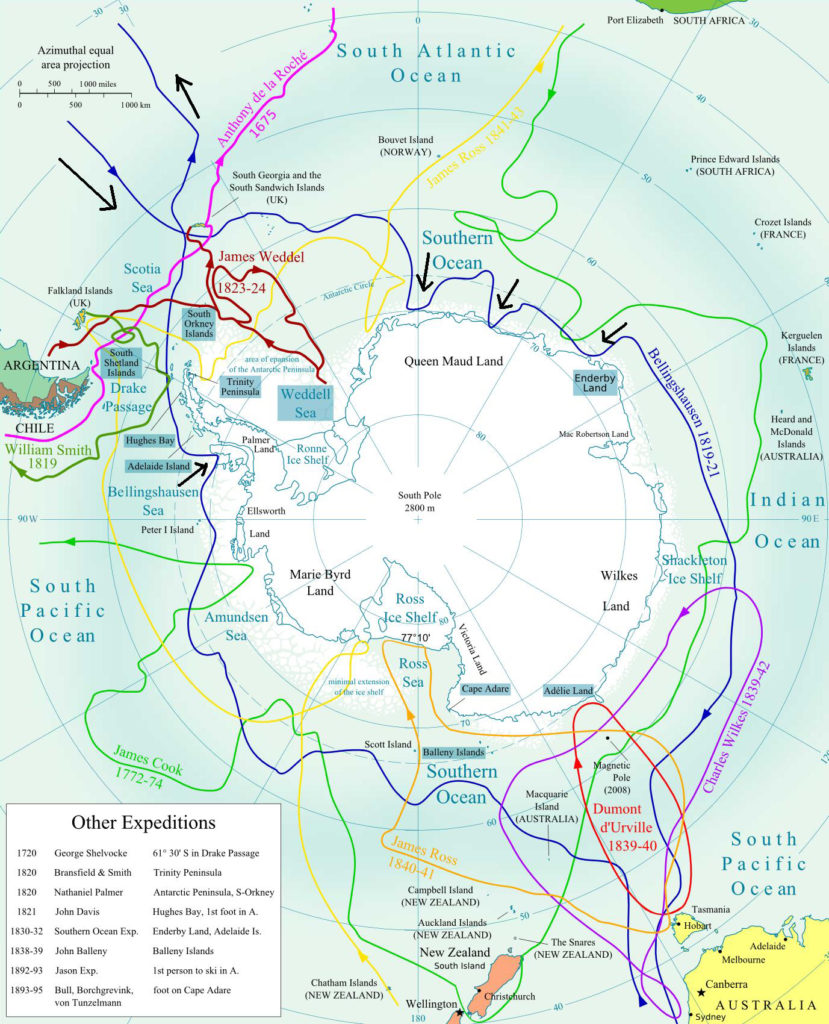
The first landings in Antarctica
An unconfirmed first landing at Hughes Bay, on the northwest coast of the Antarctic Peninsula, may have been made on 7 February 1821 by Captain John Davis and crew members from the American sealing ship Cecilia, which had been sailing in the vicinity of the South Shetland Islands in search of seals. The ship’s log recorded that men were ashore to look for seals at latitude 64°01’S. The logbook entry concluded with the statement, “I think this Southern Land to be a Continent.”
The first substantiated landing in Antarctica was not made until 74 years later, on 24 January 1895, when seven men from the Norwegian whaling and sealing ship Antarctic, came ashore in the vicinity of Cape Adare, on the Ross Sea almost due south of New Zealand. New Zealander Alexander Francis Henry von Tunzelmann is sometimes credited as being the first person to set foot on the Antarctic mainland.
For more information on Fabien Bellingshausen & Mikhail Lazarev
Fabien Gottlieb Von Bellingshausen (1778-1852): https://antarctic-logistics.com/2010/08/28/fabian-gottlieb-von-bellingshausen/
Mikhail Lazarev (1788-1851): https://antarctic-logistics.com/2010/08/28/mikhail-lazarev/
For more information on Edward Bransfield:
Remembering Edward Bransfield: http://rememberingedwardbransfield.ie